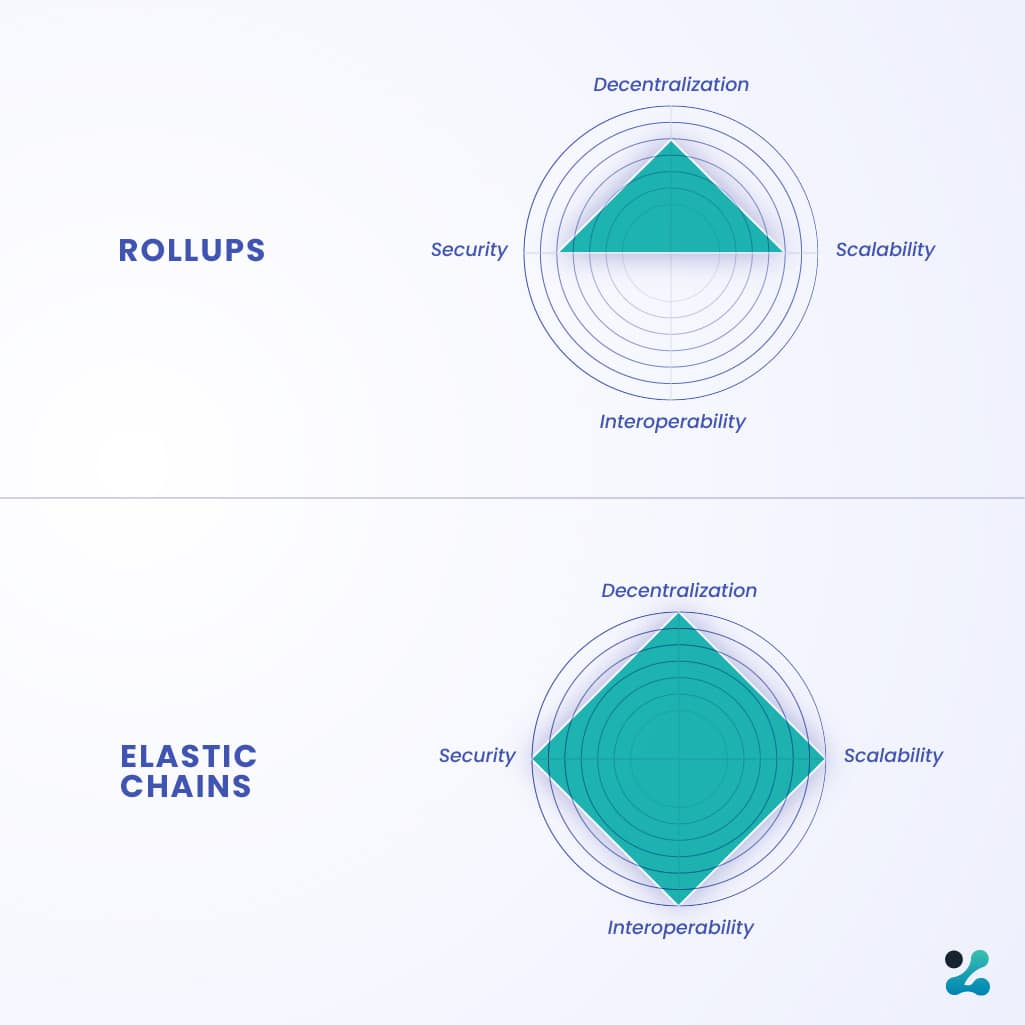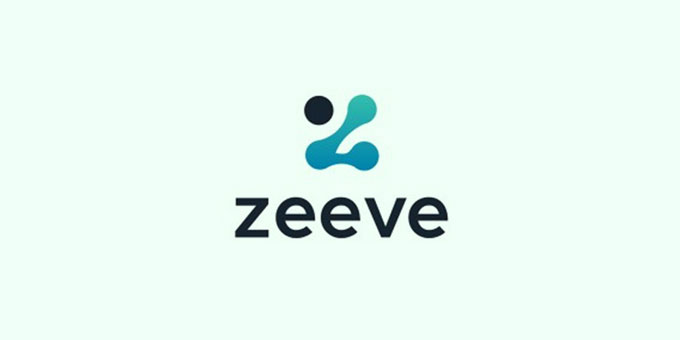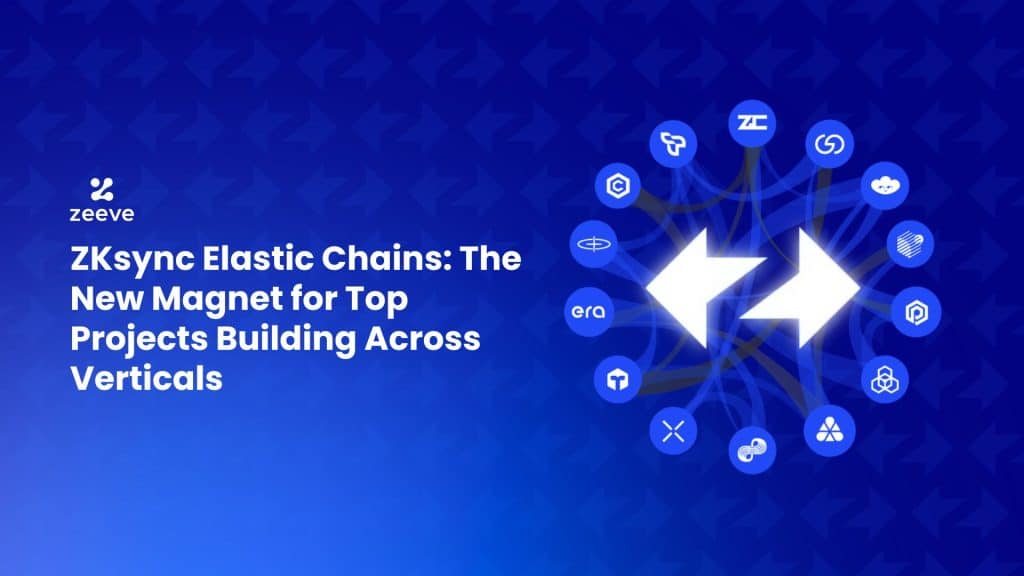“Blockchain’s structural problem is the biggest roadblock to its adoption.”
That’s a very bold statement to use for a sector that is changing the face of finance. However, one has to acknowledge that you cannot see the rigidity of blockchains as something that is non-concerning for project owners. Why? Because every project wants to own its environment on its terms, blockchains disapprove of this due to its rigid technical infrastructure.
For example, imagine your project demanding 5000 theoretical TPS, but the underlying chain can meet only half of that due to its structural limitations. Or, you want to give very simple UX to your users akin to Web 2, but blockchain’s architecture has been designed in such a way that every activity/action must be validated via consensus, demanding interaction with smart contracts.
These drawbacks are enough to influence the UX and restrain you from using blockchains. That’s where ZK Stack is making the difference, and top ZKsync Elastic Chain(s) projects are flooding the Web 3 space by solving some of their key innate problems. We shall look at how ZKsync’s ZK Stack has helped some of the top projects solve their problems when launched as Elastic Chain(s).
Why Was Launching As An Elastic Chain(s) Project Beneficial For Project Owners?
- Lens Protocol: A SocialFi Network with More than 100K Users Base
As a decentralized social graph, Lens Protocol wanted to give verifiability and ownership to its users to build a scalable and gratifying creator economy. However, catering to a segment that is already a billion in user base ripe for innovation, the protocol demanded scalability on-chain without diluting decentralization because traditional social media has been struggling under centralization. ZK Stack provided a way out to launch as Elastic Chain(s) where Lens Protocol can match hyperscaling by scaling horizontally for every social application launched on top of it without sacrificing decentralization and security.
In addition to this, the top ZKsync Elastic Chain(s) projects can also communicate with Lens Protocol social apps, allowing integration with both EVM and non-EVM chains, which makes Lens Protocol the central hub for launching social applications for a variety of use cases.
Following Lens, ‘Creator’ is another project in the Creator Economy segment that is looking forward to tapping the benefits of the Zk Stack Elastic Chains, and with time, we can expect more to follow emerging as the ZKsync Elastic Chain projects. .
- Memento: On a Way To Attract 14 M Customer Base of Deutsche Bank To Bridge TradFi with DeFi
Memento blockchain has been spearheading a change by unifying two sectors, TradFi and DeFi, in which they wanted to introduce digital fund management and investment servicing. In this pursuit, Memento wanted to provide (i) Superior UX, (ii) Capital efficiency, and (iii) Network integrity. ZKsync Elastic Chain(s) have been handy in promising these. Through the use of ZKsync-powered Elastic Chain, Memento achieved verifiability through ZKproofs. One chain interface for all rollups allowed interoperability akin to the Polygon Agglayer with all other applications deployed on top of the ZKsync Elastic Chain(s). At the same time, higher throughput through fractal scaling and shared liquidity with all other DeFi apps ensured a superior UX.

Zeeve RaaS helped Memento manage customization, compliance, security, essential development tools, enhanced security, DDoS protection, and malware defense that are required when launching your own ZKsync Elastic Chain. Read more about it here.
In this way, Memento has been able to meet with both compliances and innovations, courtesy of ZKsync’s Elastic Chain(s), which have helped them in meeting all these objectives.
Sophon, which is another ZKsync Elastic Chain project in DeFi, aimed to transform the entertainment industry using the Elastic Chain(s) to simplify participation and scalability to give tough competition to Spotify. So far, Sophon has sold more than 121,000 Network nodes and raised $62.7 M and counting. The path of DeFi is bright, and ZK technology is used to build a scalable ecosystem.
- ZK Candy: The Web3 counterpart of 300M user-powered Australian gaming giant iCandy
As a gaming ecosystem, ZKCandy wanted to bring the simplicity and entertainment of the Web 2 games to Web 3. However, it is easier said than done when you know that you need a standardized tech stack that can both scale and blend with a Web 2 stack without compromising sovereignty. ZKsync Elastic Chain(s) using the Zk Stack allow this to happen where all the entertainment and interactiveness of Web 2 games can be introduced to Web 3 games.
At the same time, the use of a standardized ZK Stack for all the applications built on top of the Elastic Chain(s) ensures seamless interoperability. As a result, the ZK Candy ecosystem which wanted to provide an ecosystem beyond games where not just iCandy game users can switch to the ZK Candy environment but could do much more than that. Use of Elastic Chain(s) has ensured that not just a scalable and interoperable gaming experience but even allowing DeFi to take over where meme coins can be easily integrated into the system and easily tradable, making ZK Candy a credible Zksync Elastic Chain project.
Since Elastic Chain(s) rollups function as a one comprehensive system, you do not need different wallets or bridges to interact with different rollups ecosystems on which these ZK Candy games are functional, but just one simple wallet and bridge operational with all the applications. In this way, the NFTs and assets that you can collect in one game can be easily traded with other gaming ecosystems where it could be more in demand. Hence paving the way for building one unified community and a singular gaming ecosystem for all games launched on top of the Elastic Chain(s). If these benefits do not encourage top projects to build as ZKsync Elastic Chain projects, there’s nothing much that a protocol can provide than this.
Not just ZK Candy, PlayFi, and Blob are a few other games that are also building on top of the Elastic Chain(s) as ZKsync Elastic Chain projects.
- Nodle Network: A DePIN with 1 million nodes and 200,000 daily active users
Imagine a network that wants to build a decentralized public infrastructure where every phone and IoT device becomes an integral part of a company’s possession and you get paid for the same. Looks like a utopian dream, however, the only challenge is to meet scalability and simplified onboarding. Why? Because, everyone wants to monetize on an earning opportunity and they want to do that in a simple way. ZKsync Elastic Chain(s) are the only rollups ecosystem in the Web 3 space that allow Native Account Abstraction (NAA) where arbitrary logic can be put into the smart contract. The trade-off, easier onboarding since you want to allow every mobile phone to be used as a decentralized public infrastructure.
At the time of writing, there are over 15 billion mobile phones with active Internet connection. To absorb all of that, you need a robust ecosystem that simplifies onboarding and operations. ZKsync Elastic Chain allowed Nodle Network to introduce traditional authentication primitives to be used in the ecosystem for onboarding new users like faceID, biometric and passkeys. Along with this, the interoperability feature of the ZKsync Elastic Chain(s) allows cross rollup interaction with minimal to no complexity whatsoever. Thereby allowing superior UX experience that most of the applications are seeking right at this moment for streamlining massive level adoption.
“We are thrilled to launch the Nodle network on Ethereum through the Layer 2 ZKsync Elastic Chain(s). We look forward to contributing to the community by bringing Nodle, the fastest growing DePIN, with more than 1,000,000 token holders, and Click, the world’s first Digital Trust Network, to Ethereum,” said Garrett Kinsman, Co-Founder of Nodle. “By integrating Nodle’s first app, Click, with Ethereum, Nodle brings a much-needed real-world consumer use case to the blockchain as a ZKSync Elastic chain project.”
- QuarkID: A Decentralized Identity Protocol with a 750 Million User Vision
While a lot of projects that are working towards building a decentralized digital identity of the users have restored the narrative of protecting user’s identity, it cannot be debatable that the process has been mired in controversies. For example, a recent digital ID initiative in Kenya was ruled illegal by the government because it didn’t comply with data privacy risks that most of the GDPR guidelines followed in the EU and the US demand. QuardID provided a noble solution to this problem using the ZK Stack to build their DIDs.
They did this through launching their platform on Elastic Chain(s) which not only allowed data privacy by adhering to all GDPR guidelines but also allowed exchange of the information cross-chain for better operations. Through this QuarkID more than 650 million people in Latin America have been empowered and it is expected that it would soon be global in the coming days and courtesy to ZK Stack technology that allows privacy preserving data transfer and storage. More ZK sync Elastic Chain projects around the DID model will rise after the success of QuarkID in meeting regulations and maintaining privacy and permissioned access.
- GRVT Exchange: Targeting the $2.9 Trillion Web 3 Derivative Market using Elastic Chain(s)
We have been a huge fan of traditional finance due to its efficiency and user experience but one cannot overlook the fact that the experience can turn sour at a blink of an eye. Why? Custodianship. FTX and Wazir X have been perfect examples of the risks of putting the custody of your assets in someone else’s hands. .
Dexes have undoubtedly provided a way out but not without a loophole of complex UX where you have to separately manage the private keys, indulge in maintaining different wallets and use different bridging mechanisms to bring funds from different protocols.
In this regard, Gravity wanted to provide a better experience but ensuring a self sovereign environment that is decentralized and secure at the same time was the problem that required an innovative solution. Launching as a ZK Sync Elastic Chain project provided scalability, on-chain data privacy, self-custody support, high TPS for fast settlement and clearing, and top-tier security to Gravity..
All of these have made GRVT exchange function as a private appchain but inherit all the security and transparency of a public blockchain. Allegiance to ZKsync’s Elastic Chain(s) that have made this possible for Gravity to touch 600,000 Trades Per Second, which was a major barrier to break in order to fuse the best of both tradFi and DeFi.
Now, on Gravity, it is possible to enjoy self custody of blockchains and high throughput and simple user experience of Tradfi served at a common place. As a result, GRVT is flooding the liquidity market by partnering with more than 16 leading industry market makers with the likes of Galaxy Trading Asia Limited., Ampersan, Amber Group, IMC, Flow Traders, Pulsar, QCP, Selini. This alliance is all set to bring 2.5 M new users on GRVT beta testnet launch with a monthly trading volume of $3.3 billion.
- Space and Time: Raised $20 M To Bring Data intelligence To Blockchains
Blockchains are a treasure trove of data but only to get wasted with no considerable outcome, until and unless, accessible in a multi-chain ecosystem. However, non-standardized technology makes this pursuit impossible. By launching as a ZKsync Elastic Chain project allowed Space and Time to provide an opportunity to bring the impact of data intelligence on blockchains.
Through the use of Zksync Elastic Chain(s), projects can for the first time extract all the information of data point, transaction, wallet balance, and smart contract event from each rollup across the ever-expanding network of ZK Chains in a trustless way. Erstwhile , there was no technology in place to do the same but ZKsync’s ZK Stack helped Space and Time to launch as Elastic Chain where they can program their own logic without having to get restricted by infrastructure bottlenecks of blockchains and interact with a larger Web 3 ecosystem. In this way, for the first time, it is able to extract signals from data which was not possible in the past. Through this project, the Web 3 projects have already started their journey to explore the upside of data mining and intelligence to help scale sectors in Web 3 to the next level through predictive intelligence.
The privacy-preserving features, scalability, native account abstraction, interoperability, and security have made it possible for more ZKsync Elastic Chain projects to emerge and build the next-generation, future-ready custom blockchain ecosystem. If you wish to build your custom use cases specific to the ZKsync Elastic Chain, you need a trusted partner.

Launch Your Own ZKsync Elastic Chain with Zeeve RaaS
Zeeve, as the leading Rollups-as-a-Service provider, has been committed to providing the necessary tools that you need to build your own ZKsync Elastic Chain(s) Project. Zeeve brings valuable integration partners and provides necessary support and assistance that can help you in launching your ZKsync Elastic Chain Project in minimum possible time. Projects can quickly launch as a testnet Elastic chain network with our ZKsync sandbox tool.
To get more updates and assistance on how you can launch your Elastic Chains(s), our experts are just a click or a call away.






















